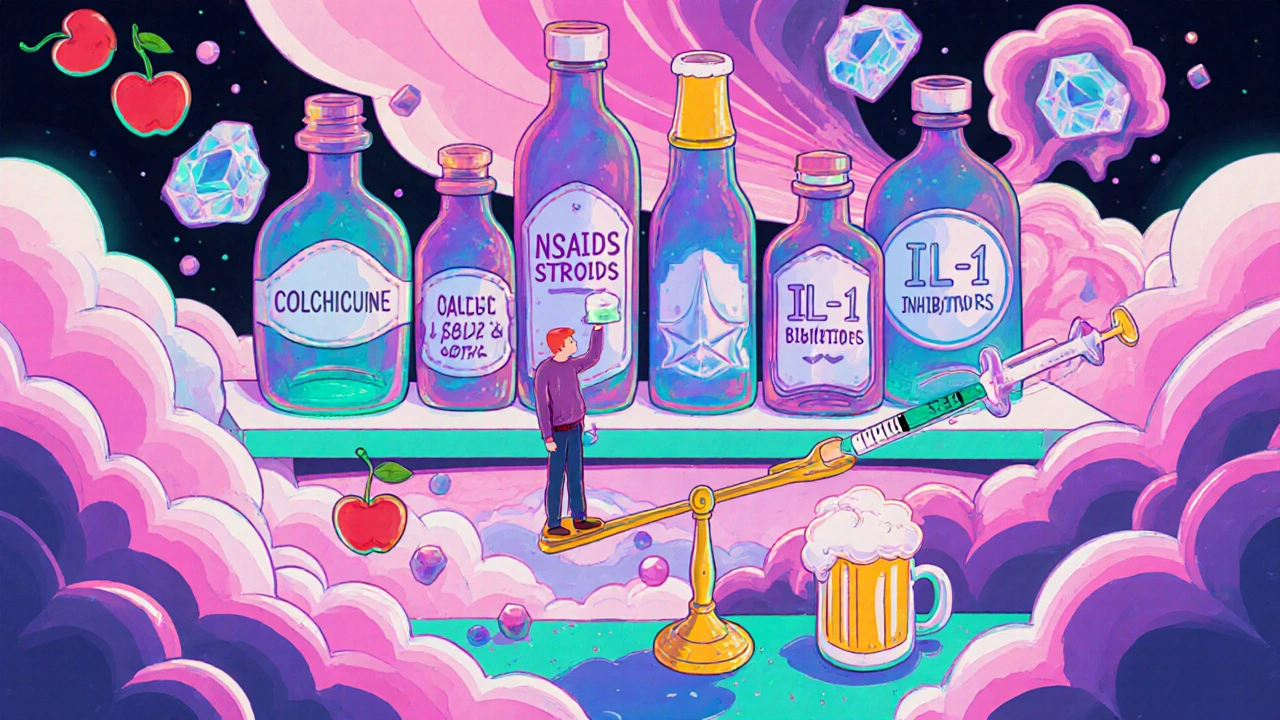Colchicine has been used for centuries to treat gout, but it’s not the only option anymore. If you’re dealing with flare-ups, swelling, or joint pain, you’ve probably heard of colchicine-but maybe you’re wondering if there’s something better, safer, or easier to tolerate. The truth is, while colchicine works, it’s not for everyone. Many people stop taking it because of nausea, diarrhea, or muscle weakness. That’s why doctors and patients are turning to other treatments. Here’s how colchicine stacks up against the most common alternatives today.
How Colchicine Actually Works
Colchicine doesn’t lower uric acid like allopurinol does. Instead, it stops inflammation in its tracks. When uric acid crystals form in your joints, your immune system sends white blood cells to attack them. That’s what causes the redness, heat, and terrible pain. Colchicine blocks those cells from moving into the joint, calming the attack before it gets worse. It’s fast-most people feel relief within 24 to 48 hours if they start early.
But here’s the catch: the dose matters. The old standard was 1.2 mg at the first sign of pain, then 0.6 mg an hour later. Today, guidelines from the American College of Rheumatology recommend just 1.2 mg total, followed by 0.6 mg one hour later. Higher doses don’t help more-they just increase side effects. In fact, the European League Against Rheumatism says you should never take more than 1.8 mg in 24 hours for acute gout.
Colchicine’s Biggest Problems
Even at low doses, about 1 in 3 people get stomach trouble. Nausea, vomiting, and diarrhea are common. Some people can’t take it at all. Others stop because the side effects feel worse than the gout flare.
Colchicine also interacts with a lot of common drugs. If you’re on statins like atorvastatin or simvastatin, the combination can cause dangerous muscle damage. It’s risky with certain antibiotics like clarithromycin, and even some heart medications. Blood tests to check kidney and liver function are often needed before and during treatment.
And it’s not safe for everyone. People with kidney disease, especially those on dialysis, are at higher risk of toxicity. Older adults, especially over 65, need lower doses. Pregnant women are usually advised against it unless the benefit clearly outweighs the risk.
Alternative 1: NSAIDs (Ibuprofen, Naproxen)
Nonsteroidal anti-inflammatory drugs are often the first choice for gout if you don’t have stomach or heart issues. Ibuprofen (800 mg three times a day) and naproxen (500 mg twice daily) reduce pain and swelling just as fast as colchicine in many cases.
Studies show NSAIDs work just as well as colchicine for acute gout, with fewer gastrointestinal side effects at standard doses. A 2023 meta-analysis in The Lancet Rheumatology found that naproxen had a lower dropout rate due to side effects compared to colchicine.
But NSAIDs aren’t perfect. They can cause stomach ulcers, raise blood pressure, and stress the kidneys. If you have high blood pressure, heart failure, or chronic kidney disease, they’re not recommended. People over 70 or those taking blood thinners should use them with caution.
Alternative 2: Corticosteroids (Prednisone, Methylprednisolone)
If you can’t take colchicine or NSAIDs, corticosteroids are the next go-to. Prednisone, taken orally, is common. A typical course is 30-40 mg daily for 3-5 days, then slowly tapered. For one bad joint, a doctor might inject cortisone directly into the area.
A 2022 trial in Arthritis & Rheumatology showed oral prednisone worked just as well as colchicine for pain relief, with fewer digestive side effects. Patients on steroids reported better tolerance and higher satisfaction.
But steroids aren’t harmless. Long-term use can lead to weight gain, high blood sugar, bone thinning, and mood changes. That’s why they’re usually reserved for short bursts. People with diabetes, osteoporosis, or a history of infections need to be monitored closely.
Alternative 3: IL-1 Inhibitors (Canakinumab, Anakinra)
These are newer, targeted biologic drugs. They block interleukin-1, a key protein that drives gout inflammation. Canakinumab (Ilaris) is given as a shot once a month. Anakinra (Kineret) is daily.
They’re not first-line. They’re expensive-over $10,000 per year-and usually reserved for people who’ve failed colchicine, NSAIDs, and steroids. But for those with frequent flares or kidney problems, they’re a game-changer.
A 2024 study in New England Journal of Medicine found that canakinumab reduced gout flares by 70% over 16 weeks in patients who couldn’t tolerate other drugs. Side effects are mostly injection-site reactions and a slightly higher risk of infections.
Alternative 4: Febuxostat and Allopurinol (For Prevention, Not Acute Flares)
These aren’t alternatives for stopping a flare-they’re for preventing them. Colchicine is often used alongside them during the first few months of treatment because lowering uric acid too fast can trigger flares.
Allopurinol is the oldest and cheapest. It’s safe for most people, including those with mild kidney disease. Febuxostat (Uloric) works faster and is used when allopurinol doesn’t work or causes rash. But febuxostat carries a higher risk of heart-related death in people with existing heart disease, according to the FDA’s 2020 safety warning.
If you’re on either of these, you’ll likely still need colchicine or another anti-inflammatory for the first 3-6 months. That’s because uric acid crystals don’t vanish overnight. Your body needs time to clear them out, and that process can trigger inflammation.
Which Alternative Is Right for You?
There’s no single best option. It depends on your health, your history, and what you can tolerate.
If you’re young, healthy, and have no stomach or kidney issues, NSAIDs like naproxen are often the easiest start. They’re cheap, fast, and widely available.
If you have heart disease, high blood pressure, or kidney problems, corticosteroids may be safer than NSAIDs or colchicine. A short course of prednisone can be very effective without stressing your organs.
If you’ve had multiple flare-ups, can’t take any of the above, or have severe kidney disease, IL-1 inhibitors might be worth discussing-even if they’re costly. Some insurance plans cover them after other options fail.
And if you’re trying to prevent future flares, don’t skip the uric acid-lowering drugs. Colchicine is often part of that plan, but it’s not the only tool.

What to Do If Colchicine Doesn’t Work
If you’ve tried colchicine and it didn’t help-or you couldn’t stick with it-don’t assume you’re out of options. Talk to your doctor about switching to an NSAID or steroid. Many patients don’t realize these alternatives exist.
Keep a log: when your flare started, how bad the pain was, what you took, and how you felt 24 hours later. This helps your doctor see what works for you, not just what works on average.
Also, don’t wait until the pain is unbearable to take your medicine. The earlier you start, the better any treatment works. That goes for colchicine, NSAIDs, or steroids.
Bottom Line: Colchicine Isn’t the Only Way
Colchicine has a long history, but it’s not the gold standard anymore. It’s one tool in a bigger box. For many people, NSAIDs or steroids are just as effective-and easier to take. For others with complex health issues, biologics offer real relief.
The goal isn’t to find the "best" drug. It’s to find the one that works for your body, your lifestyle, and your health risks. Ask your doctor about alternatives. Don’t assume you have to live with side effects just because colchicine is the most famous option.
Can I take colchicine and ibuprofen together?
Yes, but only under medical supervision. Combining colchicine with NSAIDs like ibuprofen increases the risk of side effects, especially muscle damage and kidney stress. Most doctors avoid this combo unless absolutely necessary. If you need both, your doctor will likely use lower doses and monitor you closely.
Is colchicine better than steroids for gout?
It depends. For healthy people without other conditions, colchicine and steroids work about equally well for acute gout. But steroids are often preferred if you have kidney disease, stomach ulcers, or heart problems. Colchicine has more drug interactions and is harder to tolerate for many. Steroids are faster to clear from your system, which makes them safer for short-term use.
What are the safest long-term options for gout?
Long-term gout management isn’t about treating flares-it’s about lowering uric acid. Allopurinol is the most common and safest long-term option for most people. Febuxostat is an alternative if allopurinol doesn’t work. Colchicine is sometimes used long-term at low doses (0.6 mg daily) to prevent flares while uric acid levels drop, but it’s not a cure. Lifestyle changes-reducing alcohol, avoiding sugary drinks, losing weight-are just as important.
Why does colchicine cause diarrhea?
Colchicine affects rapidly dividing cells-including those in your gut lining. It slows down the movement of immune cells, but it also interferes with how your intestines absorb fluids and nutrients. This leads to watery stools, cramping, and nausea. Even low doses can cause this. If diarrhea starts, stop the medication and talk to your doctor. It’s not normal to have ongoing digestive issues on colchicine.
Are there natural alternatives to colchicine?
No natural remedy has been proven to stop a gout flare like colchicine does. Cherries, vitamin C, and celery seed may help lower uric acid slightly over time, but they won’t treat an active flare. Relying on them instead of proven medication can lead to more damage in your joints. If you want to use supplements, talk to your doctor first-they can interact with your other meds.
Next Steps: What to Do Today
If you’re currently taking colchicine and having side effects, don’t quit cold turkey. Talk to your doctor. They can help you switch safely.
If you’ve never tried other options, ask: "Is there a better choice for me based on my health history?" Bring your medication list. Mention any kidney, heart, or stomach issues.
If you’re managing gout long-term, focus on uric acid control-not just flare relief. Get your levels checked regularly. Cut back on beer, red meat, and high-fructose drinks. Even small changes make a big difference over time.
There’s no reason to suffer through side effects when other options exist. Colchicine helped millions-but it’s not the only path forward.

Dana Dolan
November 20, 2025 AT 15:15Colchicine gave me the worst diarrhea of my life. I thought I was dying. Switched to naproxen and barely felt a thing. Why do doctors still push this ancient pill like it's magic?